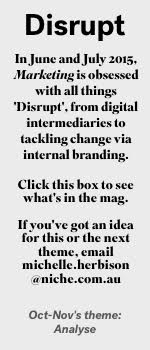Keeping up with consumers: Fairfax Media talks mobile
Share
The ever-changing digital landscape gives people a multitude of different platforms to read, watch and listen to their news. Mobile devices allow news to be accessed anywhere at any time. Fairfax Media’s mobile director Stefan Savva speaks to Marketing about how Fairfax is changing its business model to keep up with modern how audiences consume news.
 Marketing: How has mobile changed the way people consume news? Has it been quicker or more significant than you expected? Can you give us some examples and statistics to explain these changes?
Marketing: How has mobile changed the way people consume news? Has it been quicker or more significant than you expected? Can you give us some examples and statistics to explain these changes?
Stefan Savva: Mobile has had several profound changes on the way people access news. For example, our readers tell us that they used to keep themselves up to date on a daily basis but now they do this every 30 minutes. Even just in the last two years we have seen more than 50% of the Fairfax Media audience tell us they rely less on TV news bulletins because they prefer the convenience that mobile can offer.
 What’s really interesting from a digital perspective is that smartphones are an additional news source and not a replacement: 67% of our smartphone audience agree since accessing news on their smartphone, they’re accessing more news in total than ever before. So it’s not a migration to mobile but yet another platform to consume news on. In fact, within the next 18 months, smartphones will become the dominant content platform for most publishers and most readers around the world.
What’s really interesting from a digital perspective is that smartphones are an additional news source and not a replacement: 67% of our smartphone audience agree since accessing news on their smartphone, they’re accessing more news in total than ever before. So it’s not a migration to mobile but yet another platform to consume news on. In fact, within the next 18 months, smartphones will become the dominant content platform for most publishers and most readers around the world.
I don’t think anyone expected that in just eight years (since the birth of the modern smartphone) we would have seen this much disruption to user behaviour and to industry. It’s not just publishing, lots of industries are affected, so for example in camera retailing, they are seeing seismic shifts with consumers shifting their photo taking preferences away from digital cameras towards smartphones. The shift slashed revenue from that industry. Despite the image resolution on smartphones being poorer than dedicated cameras, some 380 billion photos were taken globally in 2012 [according to Fstoppers]; that’s three times the number since 2007, the year the iPhone was released.
M: Fairfax Media has created a team of mobile specialists across the business who are charged with transforming its platforms and people to mobile-first. How is what they do integrated with the company’s other platforms (i.e. desktop and print)? To what extent is Fairfax a ‘mobile-first’ company?
SS: The number of platforms people access content on is growing and we believe in letting the audience choose how they consume our content. Because of the increased user base and the increased usage, mobile will be a much larger opportunity for publishers than desktop, however it will mean we will need to do many things differently. Publishers need to be mindful that it’s not the only screen so we need to craft content experiences based on how people are using multiple platforms throughout their day.
Mobile is a key area of growth for Fairfax Media as more audiences consume content on mobile devices. Fairfax Media’s mobile audience reaches 2.8 million or one in six Australians each month [according to EMMA]. We are investing in transforming our people and products to mobile-first. In addition, we are committed to delivering innovative products and advertising solutions that engage consumers on mobile devices. Our new Mobile Creative Unit allows us to not only offer comprehensive advertising solutions across our mobile and tablet platforms, we can now build it for them too and take away one of the big pain points felt by many of our advertising clients.
M: When using their mobiles to consume content, people are spending a significant amount of time on social media apps. How does social media fit into the Fairfax mobile advertising strategy?
SS: Mobile social is very different to desktop social. Your mobile phone is a social platform in itself and has access to all your contacts, your diary, your location etc, in a way that desktop cannot match. So it’s no surprise that on desktop, Facebook was really the only social platform that mattered for so long, but that’s not true in mobile. Mobile has a great unbundling power so Facebook is one of many platforms that people spend time on. And it’s also a space that is changing very quickly so experimentation for publishers and advertisers is vital.
We found in a recent study that 65% of our audience visits a publisher for validation if they first read about something on social media and 54% find that once they’ve clicked on an article on social media, they find themselves consuming additional content with that news publisher [according to Fairfax Media Smartphone News Consumption Study]. So mobile social is very complementary and a great extension of the news experience.
M: What do you think the future of news and advertising will look like for Fairfax? Where is the mobile trend heading in the future and to what extent should we expect new technologies such as wearables to overtake it?
SS: At Fairfax Media we are busy developing the next generation of digital products for both our readers and our advertisers. It’s without doubt the most exciting time to be working in media.
Something that we have noticed changing over the last few years is that smartphones are now equally used for consuming in-depth and also lighter news content. This contradicts the idea that smartphones are used only for ‘snacking’ on news content. In fact some of our longer reads actually perform better on smartphones than any other platform.
But if you want to know what the future of digital publishing is, a fair starting point would be to look at the online and mobile habits of today’s 15-year-olds. These constantly connected individuals are no longer dual-screening they are triple-screening, and their primary screen of choice is mobile. They are more connected to the internet than ever, more willing to participate in social and sharing activities and more able to consume rich content at any time and on any device. To them, the role of a TV scheduler – someone who decides when you are allowed to watch a particular piece of content – is completely anachronistic. So the future for them is going to be focussed on context and how to give them relevant content and advertising experiences.















